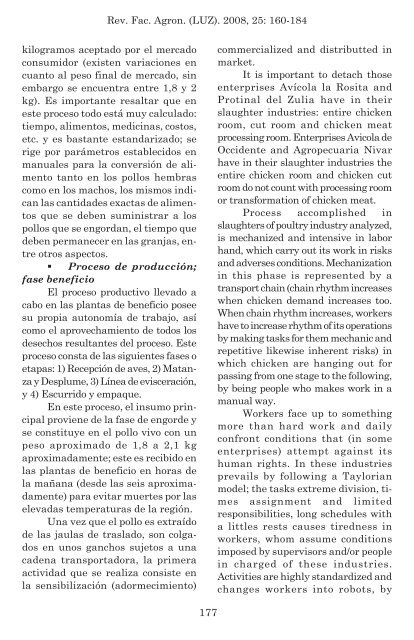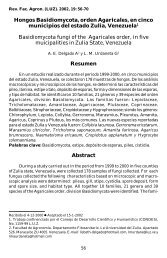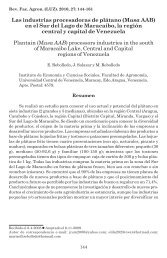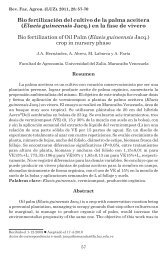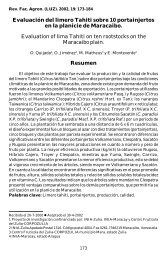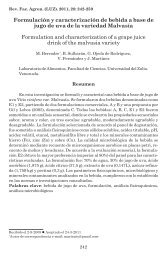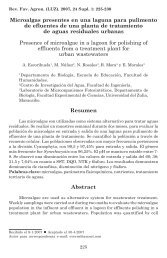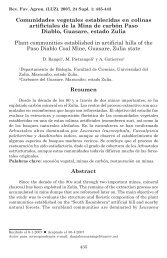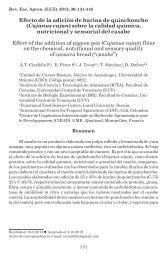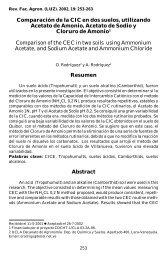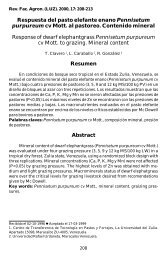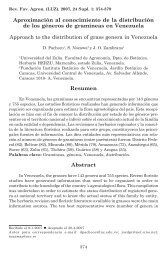Procesos productivos de la industria avÃcola zuliana - Revista de la ...
Procesos productivos de la industria avÃcola zuliana - Revista de la ...
Procesos productivos de la industria avÃcola zuliana - Revista de la ...
Create successful ePaper yourself
Turn your PDF publications into a flip-book with our unique Google optimized e-Paper software.
Rev. Fac. Agron. (LUZ). 2008, 25: 160-184<br />
kilogramos aceptado por el mercado<br />
consumidor (existen variaciones en<br />
cuanto al peso final <strong>de</strong> mercado, sin<br />
embargo se encuentra entre 1,8 y 2<br />
kg). Es importante resaltar que en<br />
este proceso todo está muy calcu<strong>la</strong>do:<br />
tiempo, alimentos, medicinas, costos,<br />
etc. y es bastante estandarizado; se<br />
rige por parámetros establecidos en<br />
manuales para <strong>la</strong> conversión <strong>de</strong> alimento<br />
tanto en los pollos hembras<br />
como en los machos, los mismos indican<br />
<strong>la</strong>s cantida<strong>de</strong>s exactas <strong>de</strong> alimentos<br />
que se <strong>de</strong>ben suministrar a los<br />
pollos que se engordan, el tiempo que<br />
<strong>de</strong>ben permanecer en <strong>la</strong>s granjas, entre<br />
otros aspectos.<br />
• Proceso <strong>de</strong> producción;<br />
fase beneficio<br />
El proceso productivo llevado a<br />
cabo en <strong>la</strong>s p<strong>la</strong>ntas <strong>de</strong> beneficio posee<br />
su propia autonomía <strong>de</strong> trabajo, así<br />
como el aprovechamiento <strong>de</strong> todos los<br />
<strong>de</strong>sechos resultantes <strong>de</strong>l proceso. Este<br />
proceso consta <strong>de</strong> <strong>la</strong>s siguientes fases o<br />
etapas: 1) Recepción <strong>de</strong> aves, 2) Matanza<br />
y Desplume, 3) Línea <strong>de</strong> evisceración,<br />
y 4) Escurrido y empaque.<br />
En este proceso, el insumo principal<br />
proviene <strong>de</strong> <strong>la</strong> fase <strong>de</strong> engor<strong>de</strong> y<br />
se constituye en el pollo vivo con un<br />
peso aproximado <strong>de</strong> 1,8 a 2,1 kg<br />
aproximadamente; este es recibido en<br />
<strong>la</strong>s p<strong>la</strong>ntas <strong>de</strong> beneficio en horas <strong>de</strong><br />
<strong>la</strong> mañana (<strong>de</strong>s<strong>de</strong> <strong>la</strong>s seis aproximadamente)<br />
para evitar muertes por <strong>la</strong>s<br />
elevadas temperaturas <strong>de</strong> <strong>la</strong> región.<br />
Una vez que el pollo es extraído<br />
<strong>de</strong> <strong>la</strong>s jau<strong>la</strong>s <strong>de</strong> tras<strong>la</strong>do, son colgados<br />
en unos ganchos sujetos a una<br />
ca<strong>de</strong>na transportadora, <strong>la</strong> primera<br />
actividad que se realiza consiste en<br />
<strong>la</strong> sensibilización (adormecimiento)<br />
commercialized and distributted in<br />
market.<br />
It is important to <strong>de</strong>tach those<br />
enterprises Avíco<strong>la</strong> <strong>la</strong> Rosita and<br />
Protinal <strong>de</strong>l Zulia have in their<br />
s<strong>la</strong>ughter industries: entire chicken<br />
room, cut room and chicken meat<br />
processing room. Enterprises Avico<strong>la</strong> <strong>de</strong><br />
Occi<strong>de</strong>nte and Agropecuaria Nivar<br />
have in their s<strong>la</strong>ughter industries the<br />
entire chicken room and chicken cut<br />
room do not count with processing room<br />
or transformation of chicken meat.<br />
Process accomplished in<br />
s<strong>la</strong>ughters of poultry industry analyzed,<br />
is mechanized and intensive in <strong>la</strong>bor<br />
hand, which carry out its work in risks<br />
and adverses conditions. Mechanization<br />
in this phase is represented by a<br />
transport chain (chain rhythm increases<br />
when chicken <strong>de</strong>mand increases too.<br />
When chain rhythm increases, workers<br />
have to increase rhythm of its operations<br />
by making tasks for them mechanic and<br />
repetitive likewise inherent risks) in<br />
which chicken are hanging out for<br />
passing from one stage to the following,<br />
by being people who makes work in a<br />
manual way.<br />
Workers face up to something<br />
more than hard work and daily<br />
confront conditions that (in some<br />
enterprises) attempt against its<br />
human rights. In these industries<br />
prevails by following a Taylorian<br />
mo<strong>de</strong>l; the tasks extreme division, times<br />
assignment and limited<br />
responsibilities, long schedules with<br />
a littles rests causes tiredness in<br />
workers, whom assume conditions<br />
imposed by supervisors and/or people<br />
in charged of these industries.<br />
Activities are highly standardized and<br />
changes workers into robots, by<br />
177


